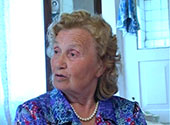
Anya Kelmenson was born and spent her childhood in Khmel'nyts'kyy. During the war, she was evacuated to Tashkent. After the war, she lived in Central Asia and later in Chisinau, eventually moving to Bratslav.
Dishes in the Attic
Bratslav, Ukraine
In Soviet times, while public displays of Jewish observance were heavily discouraged by state authorities, many Jews held on to the traditions of Passover, such as clandestinely baking and eating matzah. More than most other Jewish practices, Peysekh customs persisted among Soviet Jews, in part because of the symbolic content of the holiday's message of national liberation, and because of the memory of participation in the Seyder as children.
In the early years of the Soviet Union, the Jewish Sections of the Communist Party published so called Red Hagaddahs that tried to retell the Passover story as a story of the liberation of the proletariat from the oppression of the bourgeoisie. These Red Hagaddahs were widely distributed through Communist Party youth organizations. Almost none of the people we interviewed remembered the Red Hagaddahs. Instead, they recall traditional seders with their families, but often have difficulty recalling specific details of the ceremony.
